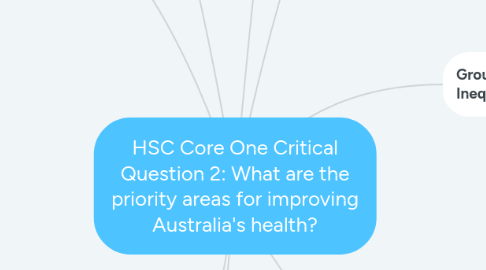
1. High Levels of Preventable Chronic Disease, Injury and Mental Health Problems
1.1. Injury
1.1.1. 6% of annual deaths are responsible for approx 400 000 hospital admissions each year .
1.1.2. ATSI and young men in rural settings are at high risk of injury.
1.2. Mental Health
1.2.1. Is a condition that negatively affects an individuals brain and changes the way they thinks, feel, behave and relate to others and their environment.
1.2.2. Everyone can suffer a form of mental illness but those who are exposed to bad influences and experiences more frequently are more susceptible.
2. High Levels of Preventable Chronic Disease, Injury and Mental Health Problems
2.1. Diabetes
2.1.1. Is the fifth National Health Priority Area
2.1.2. Is a common, chronic and costly disease which is an enormous personal and public health burden.
2.1.3. Both incidence and prevalence are rising worldwide.
2.1.4. Federal government has allocated funding of 7.7 million in its 1996-7 Budget for National Diabetes Strategy initiatives.
2.2. Respiratory Disease
2.2.1. Asthma is a chronic disease of the respiratory system or airways. The inside walls of the airways become narrow, making it hard to breathe.
2.2.2. Inflammation makes the airway sensitive and they then react to certain triggers.
2.2.3. When symptoms such as wheezing and coughing worsen, an asthma attack can occur.
3. A Growing and Aging Population
3.1. Healthy Ageing
3.1.1. Healthy ageing is about optimizing opportunities for good health, so that older people can take an active part in society and enjoy an independent and high quality of life
3.2. Increased Population Living with Chronic Disease or Disability
3.2.1. As Australia’s population continues to age, there is an increased population living with chronic disease and disability. This is because chronic disease and disability are more prevalent in the elderly. This is especially the case as survival rates from many chronic diseases increases, resulting in decreased quality of living and independence.
3.2.2. Chronic disease is the greatest issue for Australia’s health and has a large burden on the population. Diseases such as cancer, diabetes, cardiovascular disease, cerebrovascular disease and respiratory disease and mental health issues continue to impact Australian society and can lead to debilitating conditions.
4. A Growing and Ageing Population
4.1. Demand for Health Services and Workforce Shortages
4.1.1. A growing and ageing population increases the demand for health services and creates workforce shortages in the health service as an increase in the workforce would be required. There is concern that the ageing population will increase public spending on health and place an unsustainable strain on the health system trying to serve the increasing cliental.
4.1.2. The increase in aged care facilities also require an increase in workforce training in aged care and issues surrounding chronic diseases and disability. An ageing population requires an adequate health workforce. This relates to not only the number in the workforce, but their distribution and skills as well.
4.2. Availability of Careers and Volunteers
4.2.1. A growing and ageing population, with the increase in chronic disease and disability require an increase in carers and volunteers. A carer is someone who provides assistance in a formal paid or informal unpaid role for someone due to illness, disease or disability. Care for the elderly needs to be varied in its approach in order to meet the demands.
4.2.2. Aged care can be provided through community aged care or residential aged care. Care provided often includes daily activities such as bathing, cooking, home upkeep, and administering medications. Most informal unpaid carers are family members, particularly children or a spouse. Many carers come from charities, religious institutions, or the government.
5. Groups Experiencing Health Inequalities
5.1. ATSI
5.1.1. Life expectancy is 12-15 years less than the total Australian population.
5.1.2. Infant mortality is 2-4 times higher than the Australian average.
5.1.3. Hospitalisation among ATSI peoples id=s 50% higher than the national average
5.2. Low SES
5.2.1. Higher mortality rates for CVD
5.2.2. Higher infant mortality rates
5.2.3. Less likely to take preventative health behaviours EG BREAST SCANNING
6. High Levels of Preventable Chronic Disease, Injury and Mental Health Problems
6.1. CVD
6.1.1. Is Australia's number one killer.
6.1.2. Refers to the damage to, or disease of the heart, arteries, veins and/ or smaller blood vessels.
6.1.3. CVD includes:
6.1.3.1. Coronary Heart Disease
6.1.3.2. Stroke
6.1.3.3. Peripheral Vascular Disease
6.1.4. Modifiable risk factors
6.1.4.1. Smoking
6.1.4.2. Drinking
6.1.4.3. Exercise
6.1.4.4. Diet
6.1.5. Non-Modifiable risk factors
6.1.5.1. Genetics
6.1.5.2. Hereditary disease
6.1.6. Groups at risk
6.1.6.1. Smokers
6.1.6.2. Those with a family history
6.1.6.3. Blue collar workers
6.2. Cancer
6.2.1. include lung/melonoma / skin/ colorectal/ prostate and breast
6.2.2. 1 in 3 men and 1 in 4 women will be directly affected by cancer
6.2.3. Prostate cancer is the most common among men in Australia
7. Groups Experiencing Health Inequalities
7.1. People with Disabilities
7.1.1. In 2009, 40 million people reported having a disability.
7.1.2. The actual number of people living with a disability is INCREASING due to an ageing population.
7.1.3. Lack of support and prejudice can affect a person with a disabilities access to health services.
7.2. Elderly People
7.2.1. Australia has an ageing population and the most common causes of mortality for 65+ is:
7.2.1.1. Cancer
7.2.1.2. CVD
7.2.1.3. Stroke
7.2.2. Growing old is not the only factor influencing poor health, Low SES and education are also linked.
7.2.3. Higher rates of hospitalization, lengthier stays and more aged care facilities will affect the economy.
8. Groups Experiencing Health Inequalities
8.1. Overseas - Born Australians
8.1.1. Have better health when arrive than Aust. born population.
8.1.2. Those who don't speak English on arrival's health deteriorate because of Low SES/Poor language skills.
8.1.3. Less likely to report medical conditions/ immunise children/ exercise.
8.2. Rural Residents
8.2.1. Have poorer health than counterparts living in metropolitan areas.
8.2.2. Have higher mortality rates and lower life expectancy.
8.2.3. Experience higher hospitalization rates.
